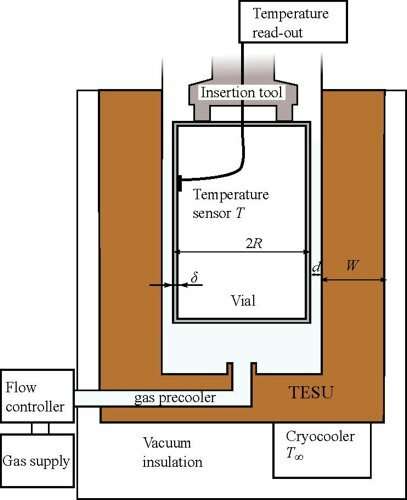Biopsy frozen in seconds in the operating room

For rapid freezing of a biopsy sample taken from a patient, the standard procedure uses liquid nitrogen. However, this is not allowed inside the operating room. The consequence is a laborious procedure causing unnecessary delay. Researchers of the University of Twente developed a 'snap freezing' apparatus that cools a vial even faster than in liquid nitrogen, and is safe for use inside the operating room. Another advantage is that the speed of cooling is adjustable. The new device is presented in Nature's Scientific Reports. The Dutch VUmc hospital is already running experiments using the new device.
For personalized cancer treatments, molecular medicine is promising. For many laboratory tests, a tissue sample for biopsy is kept at room temperature from the clinic to the lab. But for protein analysis, proteomics, the tissue has to be frozen instantly. This is also called "snap freezing," and is made possible by immersing a vial containing the tissue in a bath of liquid nitrogen, cooling it down to minus 196 degrees Celsius.
To avoid risks for the patient and medical staff, this procedure cannot be done inside the operation theatre. In practice, a clinician wearing protecting clothing waits directly outside with a liquid nitrogen container. There is still a delay in moving the sample outside, which may influence the lab results. The new snap freezer developed by UT scientist can be connected to the mains and does not present any risk of physical contact or breathing harmful cooling gas or liquid. The freezer does not require special gloves or protective clothing. The apparatus freezes vials even faster than liquid nitrogen, and is more flexible, as the cooling speed can be adjusted.
Although so-called cryocoolers are available on the market, the challenge is keeping it compact. Coolers of a cubic meter in size with the right specifications are expensive. Thanks to its smart design, the new cooler is substantially less expensive.
This very compact cryocooler has a buffer made of copper for retaining low temperatures and a closed helium gas system that works as a heat exchanger. There is a gap between the TESU and the vial with the biopsy for contact gas flow. Next to the direct cooling effect, the researchers expected to see cooling by the movement of the gas, similar to the wind chill factor, which makes the air seem colder than the actual temperature. However, this effect was not observed in this case. Apart from developing the new device, the research also provides new physical insights in gas flows.
The medical center of the Free University in Amsterdam (VUmc) is testing the device in a polyclinic setting because for actual use in the operation theatre, certification is still necessary. The team lead by Srinivas Vanapalli is also working on a sustainable solution for cold transport, for example, when a tissue sample has to be transported over a large distance to another lab. Rapid cooling devices are also promising in treatment, killing tumor cells in a highly targeted way. This is currently another field of research addressed together with cryoablation specialists.
More information: Michiel A. J. van Limbeek et al. Cooling of a vial in a snapfreezing device without using sacrificial cryogens, Scientific Reports (2019). DOI: 10.1038/s41598-019-40115-6
Journal information: Scientific Reports
Provided by University of Twente



















